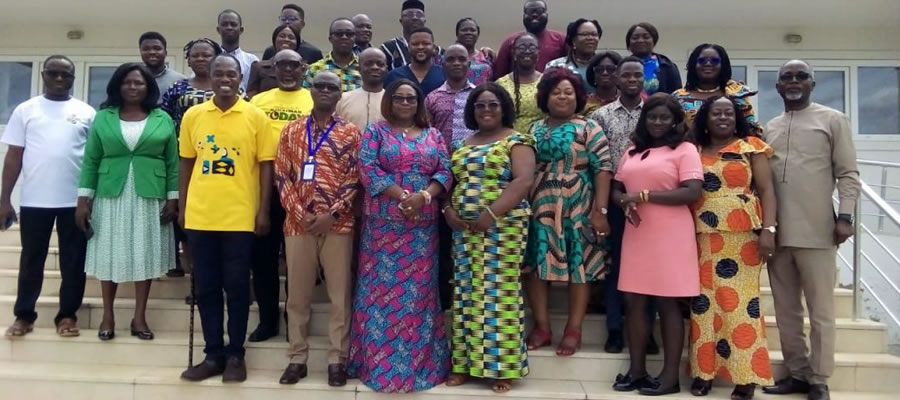

Location & size
Nkoranza South Municipal is one of the twenty-seven (27) administrative districts in the Brong Ahafo Region of Ghana. It is located in the middle portion of the Brong Ahafo Region. It lies within Longitudes 1O10’W and 1O55’W and Latitudes 7O20’N and 7O55’N, covering a total are of.
The municipality shares boundaries with Nkoranza North District to the North, Techiman Municipality to the West, all in the Brong Ahafo Region and Offinso North and Ejura-Sekyere-Dumase (all in Ashanti Region) to the South and South –East. With land size of 1,100km2, it has about 126 settlements traditionally headed by one paramount chief. Figure 1 & 2 shows the map of Nkoranza South Municipal regional and national context.
Topology & drainage
Generally low lying and rising gradually from 153m - 305m above sea level, the district is fairly drained by several streams and rivers, notable among which are the Pru, Tanko, Fanku, Abubre and Agimfra.
Most of the rivers and streams take their sources from the North - Eastern portion of the assembly, flowing south and north-westwards,
Generally low lying and rising gradually from 153m to 305m above sea level. The municipality is fairly drained by several streams and rivers, notable among which are the Pru, Afuofu and Fia. Most of the rivers and streams take their sources from the north-eastern portion of the municipality, flowing south and north-westwards.
The rivers and streams present potential sources of surface water which can be treated and distributed for household consumption and other uses. Currently, communities around the frontiers of these rivers use them as their source of drinking water especially those without potable water.
Climate & vegetation
The municipality lies within the wet semi-equatorial region, having a mean annual rainfall level ranging between 800-1200mm.
The Municipality has its major rainy season from March to June, experiencing her minor rains in September to November. The month of August experiences a short dry season, with the prolonged one in the months of December to March.Though temperatures are generally high, the average annual temperature is about 26°C.
The Municipality is part of the transitional zone between the savannah woodland of northern Ghana and the forest belt of the south.
Thus, the Eastern part of is largely characterised by savanna woodland, and fewer areas of savanna regrowth.
The southern part is largely marked by forest regrowth, made up of shrubs and grasses with few original tree species, especially silk cotton trees.
The municipality lies within the wet semi-equatorial region, having a mean annual rainfall level ranging 800-1200mm. The bio-modal rainfall pattern. The major rainy season occurs during the months of March to June, experiencing the minor season during September to November.
The month of August experiences a short dry season, with prolonged one in the months of December to March. During this dry season, there is little or no rain recorded. Though temperatures in the district are generally high, the average annual temperatures in the district are generally high; the annual temperature is about 26OC.
The variation in rainfall patterns can adversely affect agricultural activity since farming in the municipality dependent on rain. Thus, livelihoods economy become threatened if rains arrive too early or too late. About 11% of field survey respondents who are employed in agriculture identified erratic whether conditions as a problem affecting their productivity.
Nkoranza South Municipality lies within the transitional zone between the savanna woodland of northern Ghana and the forest belt of the south. The district happened to be a thick forest area but the vegetation has changed to that of savannah mainly due to the adverse effects of bush fires. The change in vegetation is also due to the rapid expansion of agriculture which adopts traditional crude method. Uncontrolled operations of timber firms, the forest are being decimated.
The savanna woodland and power areas of savannah re-growth largely characterize the eastern part . The southern part is largely marked by forest re-growth, made up of shrubs and grasses with few original tree species, especially silk cotton trees. Among the effects of the deforestation are the change in the rainfall pattern and the disappearance of some forest resources such as snails, mushrooms and wildlife.
Geology & soil
The municipality is largely characterized by soils developed over voltain sand stones.This geological feature together with vegetation influences, gives rise to two distinct soil categories.One is the group of soil typed developed under forest vegetation and the other type developed under savanna vegetation.The dominant occupation of people in the municipality is agriculture, the proportion of which is about 82 per cent of labour force.
Main food crops cultivated are maize, yams, vegetables, cassava, groundnut, cowpea, cocoyam and plantain. Cotton and tobacco are also grown in some parts of the district.
Nkoranza South is underlain by the Voltaian formations which consist of quartzite, shale, mudstones, sandstones and conglomerate or pebbly beds. Although, there are areas of uniform lithology, inter-bedding of the different geological units is a common feature of the basin. Underground water potential is limited due to the Voltaian formation.
The shales and mudstones of the Obusum bed are essentially impermeable with very low groundwater potential. However, shallow aquifers can be developed in areas of good surface water hydrology. Even through the geology of the district presents low ground water potential, some boreholes chilled in the Voltaian areas have yielded up to 600 litres per minute and above.
The municipality is largely characterized by soils developed over voltaic sand stones. This geochemical feature together with vegetation influences, gives rise to two district soil categories in the district. One is the group of soil type developed under forest vegetation and other type developed under savannah vegetation. The soils in the district are known to be fertile and suitable for cereals, legumes and root crops, and also for livestock production. The soil suitability accounts for the general cultivation of maize, yams, vegetables, cassava, groundnut, cowpea, cocoyam and plantain. Cotton and tobacco grow well in some parts of the district.
Date Created : 11/29/2017 3:05:18 AM












 facebook
facebook
 twitter
twitter
 Youtube
Youtube
 +233 593 831 280
+233 593 831 280 0800 430 430
0800 430 430 GPS: GE-231-4383
GPS: GE-231-4383 info@ghanadistricts.com
info@ghanadistricts.com Box GP1044, Accra, Ghana
Box GP1044, Accra, Ghana